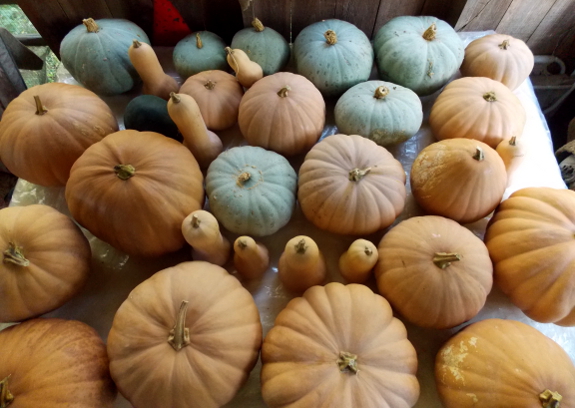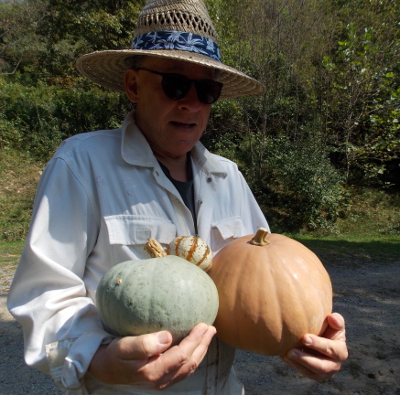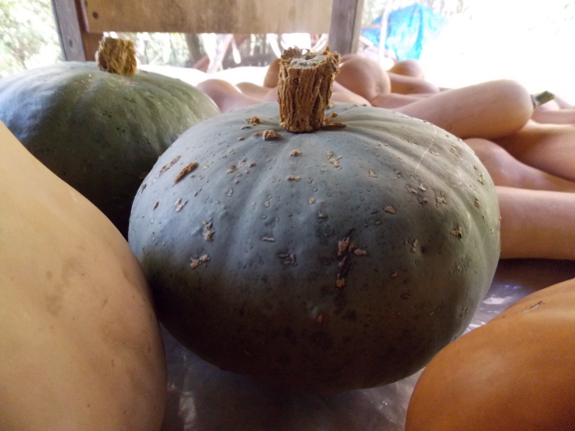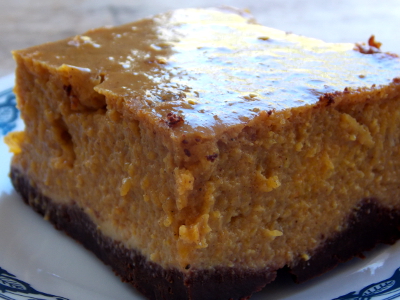
Blue hubbard squash

One of our first
years on the farm, Mark and I grew several different kinds of
winter squash and settled on butternuts as both the tastiest and
the most pest-and-disease-resistant variety. Ever since,
we've been a purely butternut farm.
 But I love trying new things. So when
my movie-star neighbor offered me some of his homegrown squashes,
I had to give them a try. I've yet to cut into the pie
pumpkin he gave me, but I cooked up the blue hubbard into a
pie Sunday, and it was one of the best I've ever eaten.
But I love trying new things. So when
my movie-star neighbor offered me some of his homegrown squashes,
I had to give them a try. I've yet to cut into the pie
pumpkin he gave me, but I cooked up the blue hubbard into a
pie Sunday, and it was one of the best I've ever eaten.
Will we start growing
hubbard squash as a result? Well, there are several factors
to consider. If you're a seed saver, you have to think long
and hard before adding new squash varieties to your garden, but it
turns out that blue hubbards wouldn't be very tough for us to
integrate. Butternuts are Cucurbita moschata, summer squash are Cucurbita
pepo, and
blue hubbard is Cucurbita maxima, so I could grow all
three in the same garden without worrying about crosses.
(However, if you're more of a pumpkin person, some pumpkins do
cross with blue hubbard, as do winter marrow, turban squash, and
banana squash).

On the other hand,
since we use variety selection as our first line of defense
against squash
vine borers, we probably should skip the hubbards.
Butternuts are among the most resistant to vine borer damage, but
hubbards are so beloved by the insects that they are sometimes
used as a trap crop alongside rows of other types of squash.
Another downside of hubbards compared to butternuts is that the
hubbards are big --- even the smallest in my neighbor's collection
had enough flesh for 2.5 pies, and our small family does better
with the more minuscule butternut.
And, to be honest, I
think the reason our hubbard pie was so delicious is because I
added extra honey since the squash flesh wasn't as sweet as the
butternuts I'm more used to. You can read my
original butternut pie recipe here, and this is the new ingredient list we've
developed over the years:
 Crust:
Crust:
- 0.5 cups flour
- 0.5 cups cocoa
- 0.25 cups sugar
- 0.5 teaspoons salt
- 7 tablespoons butter
- a bit of water
Pie:
- 2 cups baked winter squash flesh
- 1.5 cups evaporated milk powder
- 1.25 cups water
- 0.5 cups of honey (or add two tablespoons to that for a sweeter pie)
- 0.5 teaspoons salt
- 1 teaspoon cinnamon
- 0.5 teaspoons allspice
- 0.25 teaspoons ginger
- 2 eggs
Click on the link
above for preparation instructions, and enjoy!
Want more in-depth information? Browse through our books.
Or explore more posts by date or by subject.
About us: Anna Hess and Mark Hamilton spent over a decade living self-sufficiently in the mountains of Virginia before moving north to start over from scratch in the foothills of Ohio. They've experimented with permaculture, no-till gardening, trailersteading, home-based microbusinesses and much more, writing about their adventures in both blogs and books.
Want to be notified when new comments are posted on this page? Click on the RSS button after you add a comment to subscribe to the comment feed, or simply check the box beside "email replies to me" while writing your comment.
- Remove comment
- Remove comment
